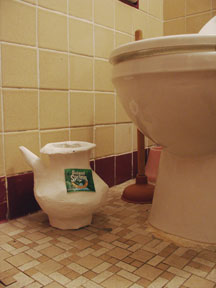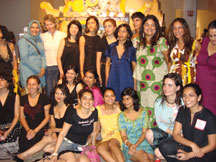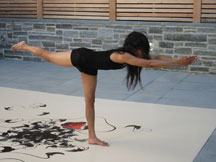Arts
The Unsuitable Girls Grow Up

But are they as subversive as ever?
What happens to the people one writes about? Are they still there, confined within the pages, or do they move on? Journalists rarely get a chance to return to a story and pick up the threads of lives they reported on.
A decade ago Little India covered the “unsuitable girls,” young artists who had come together in an organization called the South Asian Women’s Collective, with the intention of finding a space of their own, making art and breaking a few stereotypes, like subversives in a shop of delicate china. So a decade later, they are still creating a ruckus. One had only to visit “Sultana’s Dream,” the recent exhibit of over 30 artists of South Asian origin at Exit Art, a gallery in Manhattan, to realize that SAWCC, which you pronounce as SAUCY – and that’s no coincidence – is alive and well, and certainly kicking. It showed the work of noted artists like Shahzia Sikander and Chitra Ganesh, along with many other South Asian women artists, chosen from an open call for submissions. All the works are collaborations between two or more artists. The title of the exhibition, “Sultana’s Dream” hrefers to the classic short story of the same name by Rokeya Sakhawat Hussain in which the Islamic custom of keeping women in purdah is reversed, and it is the men who are relegated to the private sphere while women take on the world. The artists in this show all have something vital to say – and they say it through their art.
In Index of the Disappeared, artists Chitra Ganesh and Mariam Ghani suspend neon signs and applied vinyl lettering in English, Urdu, Arabic and Hindi painted on the walls – and these words and phrases are all taken from official documents after 9/11, evoking censorship and data blackouts that have jeopardized lives in immigrant communities. When Jaishri Abichandani, an emerging photographer in New York, founded SAWCC in 1997, it was quite a leap in the dark, not knowing whether it would take off. While there were other South Asian arts and culture movements in the UK, Toronto, and the Bay Area, New York City, in spite of a large activist community, had none. “There was no support structure for local South Asian artists, as the few galleries around exhibited only artists from India,” recalls Abichandani. “Inspired by Desh Pardesh in Toronto, I envisioned SAWCC as a democratic collective space for art and dialogue that was free of patriarchal constraints.”
About 13 women turned up for that first meeting and slowly the space for women artists was created. According to Abichandani, there are currently 1,100 members on the SAWCC listserv; some 80 women have served on the volunteer board of directors since 1998, and there are still monthly meetings and public events, which continue to attract new faces and new talents into the community. Prerana Reddy had just moved from San Francisco to New York in the 1990’s and didn’t really know how to find other South Asians, particularly women in the creative fields. She found her way to the basement in the East Village where the meeting was being held, little knowing what to expect. She was impressed by the critical discourse around the art works presented, as well as by the spirit of generosity that the space provided. “I think SAWCC was really pioneering in that way, it allowed women to find collaborators, exhibition spaces, supplies, and of course a nurturing yet challenging environment,” she recalls. Soon after it became an official non-profit, she joined the board and learned first hand what it meant to run an arts organization, yet work in a collective space.
“This experience helped me and other SAWCC women to go on and start their own organizations centered on their specific interest and mediums. Now there are several South Asian film festivals, as well as dance and theatre companies,” she says. While she still does some documentary video work, Reddy has developed into an arts administrator and curator, and is currently director of public events at the Queens Museum of Art. She believes that SAWCC really helped educate her on South Asian contemporary art and gave her the access she needed to start 3rd I NY, a South Asian film/video collective. “I definitely think SAWCC is a hrefuge for unsuitable girls of all types, but that doesn’t mean that none of us get married, become professionals, or care about what our families think of us,” she says. “Nor do we all espouse the same philosophy or politics, as anyone who has witnessed the discussions on our listserv can attest! I think what unites us is that we are invested in challenging patriarchy – battling both systematic oppression that keeps us out places of power as well as heterocentric gender norms. This in itself is definitely ‘unsuitable’ in 2007.”
Indeed, the role for the organization has changed over the years. As Abichandani points out, “When we started, we were really needed as the only feminist South Asian Arts space. We had to cater to every discipline, and many of us were learning skills as we went along. There was no local precedent for this kind of space, and women were eager to connect. I think that many of the members have come a long way since then in terms of professionalizing their practices.” The monthly meetings and the listserv have now come to represent a community portal through which South Asian women can connect to various parts of the diasporic community. “However, the original artists who founded the collective have now developed personal and professional relationships that go far beyond SAWCC,” says Abichandani. “In order to keep SAWCC relevant to them, we will have to carve a new path, one is still supportive of emerging women artists of various disciplines, but understand the needs of those who are actively exhibiting and participating in local and international art worlds. While it is great to serve as a community portal, we have to stay true to our mission of being an arts organization.” Swati Khurana, an artist who joined the group in 1997, is one of those who have gone on to publish books or gain gallery representation. She says, “Yet, many still come to SAWCC to read or exhibit their work publicly for the first time. The organization has shifted to meet the needs of members who need more critical feedback and professional networking.” The monthly meetings still are a catalyst for emerging artists to share their work in a supportive context and it seeks out new submissions. Says Khurana: “With the literary festivals, we plan readings and panels with established writers, and always have a venue for emerging writers to share their work.” Asked if the members are still “unsuitable girls” who raise inconvenient issues or have they become decorous and mature, Jaishri Abichandani laughs: “Internally, we still raise a ruckus about what is wrong in the world and spend days debating it furiously. I think we have now learnt to express that anger publicly in more formally polished ways, but it still burns bright.
“The spirit of subversiveness that fueled the collective’s beginnings is still kept alive by members, old and new. We still appreciate the positive value of the often suppressed anger of women. It can have an honest and transformative effect.” While that suppressed anger is almost a part of their work, the original members of SAWCC have developed as artists. Many have worked toward graduate degrees and engaged in a broader dialogue among other artists. Says Abichandani, “Many have matured into wonderfully thought provoking and successful artists. There is an understanding of what is going on in the New York art world and a desire to participate completely in both spheres – the South Asian and contemporary art worlds.” Abichandani herself has evolved as a conceptual artist with exhibitions coming up in Austin, Texas, Santo Domingo in the Dominican Republic and in Zurich, Switzerland. “My work explores the relationships between individual and collective selves and their effect on society. My dual practices of art and cultural production manifest as images, objects, videos, performances and exhibitions.” For three years she served as director of public events at Queens Museum of Art. She is currently curating an exhibition of South Asian diasporic artists to be held in Florida next year entitled “Exploding the Lotus.” Abichandani, who acquired a masters in visual arts from Goldsmiths College, University of London in 2005, also started a women’s collective there. Sa’dia Rehman’s sound installation “Lotah Stories” takes on the South Asian use of the lota – a water vessel, which is used in toilet ablutions in South Asia, but tends to become an object of shame and embarrassment in the West. Rehman joined SAWCC in 1998, and remembers it as a place to meet South Asian women artists and share her work with them. Her work is now showcased at prestigious venues and to a wider audience. Is she still an “unsuitable girl”? She says, “As long as I’m an artist, I will always be an unsuitable girl. I have always had a very calm and quiet demeanor and I don’t make work to purposely cause a ruckus. I make my work because I have fun making it and if it causes a ruckus or if it decorates the world, then fine.” How has she developed as an artist in the intervening decade? Says Rehman: “Now I take myself and my art seriously. At first I used to secretly believe my parents’ discouragement, but now it goes in one ear and out the other. I have a fixed studio time during the week and I dedicate half my room to studio space. “I focus on social customs constructed by my cultural identity as a PakistaniAmerican woman. I use humor to criticize serious subjects that I experienced like arranged marriage, cultural assimilation, and the division of gender roles in my family.” Childhood demons are going to be a part of her next work, a series of drawings that explore images of hell based on the stories told to her by parents, uncles and aunts and she later hopes to turn these into installation art. Khurana’s work touches upon gender and popular culture, and she has had solo exhibition in Miami at the Diaspora Vibe Gallery and at Safari Gardens in Fajara, Gambia. She also has received a travel grant from the Jerome Foundation and served as artist in residence at the Kartong Village Development Committee in Gambia, and has participated in group shows. She started with film and video and now incorporates drawing, printmaking and digital collage into her work. At the Exit Art show, Khurana commemorated the UnSuitability of these South Asian women artists by creating a series of trophies with engraved text that celebrate “our reluctant, disheveled, unproper selves,” which were captured by Anjali Bhargava. There is Meenakshi Thrukade, sitting in a shockingly, gloriously messy room, with her award for “Most Reluctant Housekeeper”! Which young South Asian woman has not been upbraided by parents for this serious flaw in the suitable girl syndrome? Khurana perhaps speaks for many of the artists when she says, “I think as I grow older, I grow more unsuitable, perhaps because I grow more comfortable in my own skin. At a certain point, I realized that my unsuitability was less of a form of rebellion, but more of a position I embraced as an adult. And what makes me so happy is that there are so many of us, who are so unsuitable, so I am not alone.” Adds Khurana, “We have been girls who seek love, desire and adventure from often other unsuitable girls and boys. We take risks, we never play dumb, we have strong opinions, we use fighting words, and we stay up late, we love our families while challenging them to accept us and the communities and families we create. Some of us even have the audacity to believe we can change the world.” Looks like we’ll be hearing a lot more from the feisty Unsuitable Girls in the future. Like fine wine, they will probably only get more intense, more flavorful with age! |






